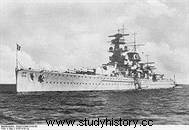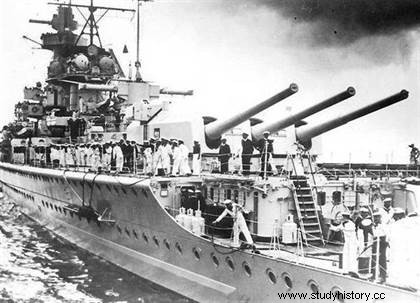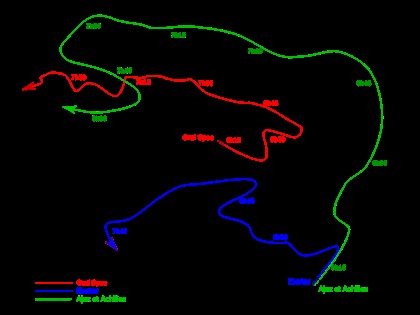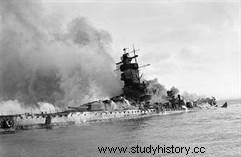 The Graf Spee was a pocket battleship of the German Navy, in service from 1936 and scuttled at the end of 1939. Belonging to a new category of warships, it was the second of this class (after the Deutschland , renamed Lützow , and before Admiral Scheer ), launched in 1934 in Wilhemshaven. This flagship of the Kriegsmarine was to terrorize the British merchant fleet at the start of the Second World War, before experiencing a tragic fate almost as striking as that of the Bismarck. His short career ended on the other side of the world, during the "battle" of Rio de la Plata, on December 13, 1939.
The Graf Spee was a pocket battleship of the German Navy, in service from 1936 and scuttled at the end of 1939. Belonging to a new category of warships, it was the second of this class (after the Deutschland , renamed Lützow , and before Admiral Scheer ), launched in 1934 in Wilhemshaven. This flagship of the Kriegsmarine was to terrorize the British merchant fleet at the start of the Second World War, before experiencing a tragic fate almost as striking as that of the Bismarck. His short career ended on the other side of the world, during the "battle" of Rio de la Plata, on December 13, 1939.
The Graf Spee, a privateer in the South Atlantic
The Treaty of Versailles (1919) imposed limits on the size of ships of the line for Germany. It was forbidden to build vessels over 10,000 tons, which in fact excluded the possibility of launching battleships. Even if Nazi Germany eventually overrode with the construction of the Bismarck , she began by skilfully circumventing these prohibitions by inventing a new class, "pocket battleships", with superior artillery to that of heavy cruisers (6x 280 mm) and a cuirass capable of withstanding their 203 mm shells, while having a limited tonnage. In addition, their speed and autonomy made them almost unattainable…
When war broke out, Admiral Raede r does not yet have at his disposal the ships he would need to stand up to the British war fleet. But he still has a substantial fleet of modern and balanced ships, capable of inflicting great damage on the allied merchant fleet. He then chose to launch his corsair fleet, made up of the three pocket battleships Deutschland (Lützow ), Graf Spee and Scheer (13,000 tons each), larger ones (16,000 tons) Scharnhorst and Gneisenau , and Hipper class heavy cruisers . All these ships of the line still have preference over U-boats.
As early as August 21, 1939, the Graf Spee takes advantage of the night to rush into the North Atlantic. He remains in a waiting position because Hitler hopes to obtain a peace to his advantage following the crushing of Poland. It was not until September 26 that the Kriegsmarine was authorized to attack Allied ships; the Graf Spee is already then in the South Atlantic… Indeed, the commander of the pocket battleship, Captain Langsdorff, had estimated that the sea routes of South America were more strategic for the enemy than those passing through the Cape of Good Hope , while the Mediterranean was still safe for the British thanks to their presence in Gibraltar and Aden.
The Graf Spee therefore headed west, towards Pernambuco (Brazil), without however having the right to engage the enemy warships himself in a battle at the end of September 1939. This did not prevent the German privateer from boarding a merchant ship on September 30:it's the Clement , under the English flag, and after having evacuated his crew by canoe, Langsdorff sank the freighter. The German captain manages to obtain from the English commander information on the instructions given to British sailors in the event of a corsair attack:to prevent the Germans at all costs from being able to use their catch as a supply vessel, by destroying radio and machinery on board.
On the way to the Indian Ocean
Langsdorff disembarks the crew of the Clement in a Brazilian port then resumed its hunt, this time heading for the Cape of Good Hope. He knows that he himself will now be hunted down. Langsdorff then uses trickery to approach his prey:he has the front and side of his turret mast repainted to pass for a merchant ship; his first success came on October 5 when he took the Newton Beech by surprise. . But as the Germans board him, the English captain still manages to send a signal and destroy important documents, except for one that will allow Langsdorff to refine his strategy. This allows the corsair new catches in the following days:the Ashlea (October 7), the Huntsman (The 10). Langsdorff sinks the first, then the Newton Beech become too slow. He obliges the Huntsman to move towards an indeterminate place, far from its route of departure; she was finally caught and sunk on October 17, her crew transferred to the German tanker Altmark …
 The Graf Spee , after leaving his supply ship and the surroundings of the island of Saint Helena, places herself on the course of the Cape to surprise the enemy ships, thanks to the information he has obtained from the Huntsman . The first victim is the Trevanion , October 22; the radio has just enough time to send an imprecise signal, but which nevertheless puts the British navy in the region on alert. The learner, Langsdorff prefers to slip away cautiously, unknowingly escaping the Renown and the French battleship Strasbourg …The same night, the Graf Spee , still cautious, almost finds himself face to face with the aircraft carrier Furious !
The Graf Spee , after leaving his supply ship and the surroundings of the island of Saint Helena, places herself on the course of the Cape to surprise the enemy ships, thanks to the information he has obtained from the Huntsman . The first victim is the Trevanion , October 22; the radio has just enough time to send an imprecise signal, but which nevertheless puts the British navy in the region on alert. The learner, Langsdorff prefers to slip away cautiously, unknowingly escaping the Renown and the French battleship Strasbourg …The same night, the Graf Spee , still cautious, almost finds himself face to face with the aircraft carrier Furious !
It was therefore decided to change course:at the end of October, the pocket battleship headed for India, but bad weather prevented her from hoping for captures in beginning of November. It was not until the second half of that same month that Langsdorff managed to find new potential victims:first it was the Dutch Holland , only glimpsed but let go, then Africa Shell which was sunk west of Madagascar on the 15th. The next day, it was the turn of the Dutchman Mapia to be arrested, but his papers checked and in view of the good behavior of his captain, Langsdorff decides to let him go…The raid of the Graf Spee in the Indian Ocean is therefore not a great success, to say the least! At the same time, the interception of numerous messages from Durban shows that the Allies are aware of the presence of a "German privateer" in the region...
Langsdorff therefore decides, despite being chased by two British squadrons, to take risks. He informed his crew on November 24 of an upcoming return to Germany to overhaul the machines, but this time without avoiding possible contact with enemy warships. The hunt for merchant ships still continues in early December:the victims are the Doric Star and the Tairoa , respectively stopped and then sunk on December 2 and 3 off Africa; then comes, on December 7, the turn of the Streaonshalh , this time off Brazil. This will be the last victim of Graf Spee; indeed, Langsdorff finds on the cargo ship documents attesting to the presence in the region of numerous potential victims. But rather than finding easy holds, the Graf Spee will have to face the British navy.
The Battle of the Rio de la Plata
On the night of December 12-13, the German ship patrolled off the Rio de la Plata. The lookout then reports two masts on the horizon; Believing in a "nice box", Langsdorff gives the order to set sail for the spotted ship. But hope gives way to bad surprise:rather than a merchant ship, the Graf Spee comes face to face with the light cruiser Exeter , followed by the Achilles and Ajax .
The Admiralty had not heard from Graf Spee for nearly twenty days when Exeter and Ajax leave Port Stanley in the Falklands on December 2. The British squadron led by Commodore Harwood joins the cruisers Achilles and Cumberland and then tries to find the German corsair. But technical problems keep the Cumberland away . This is the attack of Tairoa which allows the British navy to calculate the possible route of the Graf Spee , and the three cruisers regroup at Rio de la Plata on 10 December.
 The balance of power may seem very favorable to the British, who are three against one. But the Graf Spee is better armed and better protected than its adversaries. Each of the two camps also has several possible tactics, depending on whether it spots the other first or not (the German has a higher lookout), or whether it chooses to divide its forces or not (for the English obviously). Precisely, Harwood chose two groups:Exeter on one side, Ajax and Achilles the other. Likewise, it is indeed the Graf Spee who spots the enemy first. Langsdorff identifies Exeter , but mistakes the other two for destroyers; he also believes that these ships are an escort to a merchant convoy, and so he decides to attack without hesitation. The British lookouts initially mistook the privateer for a merchant ship, and the Exeter therefore comes to meet him without knowing what awaits him. Fortunately, Ajax manages barely a minute before the first German shell goes off to alert Exeter by identifying the corsair! It is 6:17 a.m., the fight begins.
The balance of power may seem very favorable to the British, who are three against one. But the Graf Spee is better armed and better protected than its adversaries. Each of the two camps also has several possible tactics, depending on whether it spots the other first or not (the German has a higher lookout), or whether it chooses to divide its forces or not (for the English obviously). Precisely, Harwood chose two groups:Exeter on one side, Ajax and Achilles the other. Likewise, it is indeed the Graf Spee who spots the enemy first. Langsdorff identifies Exeter , but mistakes the other two for destroyers; he also believes that these ships are an escort to a merchant convoy, and so he decides to attack without hesitation. The British lookouts initially mistook the privateer for a merchant ship, and the Exeter therefore comes to meet him without knowing what awaits him. Fortunately, Ajax manages barely a minute before the first German shell goes off to alert Exeter by identifying the corsair! It is 6:17 a.m., the fight begins.
The Exeter is hit in the third salvo by delayed shells which cause very significant damage and reduce its firing capacity! The English cruiser also manages to hit her opponent with her third salvo, but the eighth German shot disables one of her main turrets. Exeter violently struck does not turn correctly to be in ideal position, but still manages to rectify the shot and hit the Graf Spee again . This one is at 12,000 meters, taking an opposite route but parallel to his opponent. The other two British ships opened fire at 06:20, from 18,000 yards away, but aiming too short; the corsair reserves his secondary artillery for them, using his main guns against Exeter .
Langsdorff, believing that the English cruiser is sufficiently affected for the moment, decides to turn next to Ajax which threatens it with a torpedo attack; the German captain turns and touches Ajax then his companion the Achilles to starboard aft, avoiding the dreaded attack, while the Exeter is he on the aft port side. The latter is already badly damaged, as Langsdorff had correctly judged, who aimed his main shot at Ajax and Achilles . Yet on the Exeter we do not give up and three torpedoes are launched; but the Graf Spee sniffed the shot and fired:at 6:39, he again returned most of his shot on Exeter and finally puts him out of action! Two minutes earlier, Ajax and Achilles tacked to approach the corsair, taking him by surprise. The Graf Spee , at 7 a.m., heading north at 24 knots, followed on the starboard side by the two cruisers, and on the port side by an Exeter in agony; Langsdorff then decides to hide behind a smoke screen, ending the first phase of the battle.
The German captain was wounded twice during the engagement, but his ship suffered no major damage despite being hit seven times! It's time for Langsdorff to make a decision:attack or not? He knows that Exeter is not at his level, but has long believed that Ajax and Achilles are destroyers. When he finally learns their true nature, he is not determined to run away. Shortly after 7 a.m., it was the Ajax seaplane who is responsible for informing the British gunners, the damage on the various ships making it impossible to coordinate fire by radio; but it is a total confusion for several minutes between the cruisers Achilles and Ajax , suggesting a chance for the Graf Spee . Harwood, present on Ajax , nevertheless decides to get closer to his adversary:it's quits or double, to obtain a definitive victory or the putting out of action of his last two ships still valid! But the pursuit being impossible, it was probably his only choice...
When the Graf Spee turns to port to west, Harwood thinks he wants to finish the Exeter; he turns to starboard with his two cruisers to fire on the German. The latter then diverts his guns from the dying cruiser to direct them towards Ajax and Achilles . At 7:24 a.m., Ajax launches its torpedoes about 8 kilometers away but the Graf Spee spots them and avoids them. Better, he touches Ajax of a shell that destroys its two rear turrets! At 7:38 a.m., the German privateer seemed in a good position to use all his assets against his opponents, who therefore remained cautious. What's more, the firepower of Ajax is considerably reduced:in addition to the damage suffered on his artillery, he only has 20% of his ammunition left! Pessimism then takes hold of the British camp, which feels like throwing snowballs at the German ship…Harwood decides to break off the fight. The Graf Spee heading west, followed to starboard by the Achilles and to port by the Ajax . At 8:30 a.m., the two cruisers followed their enemy at a distance of 28 kilometers. This is the end of the second phase of the fight.
Aboard the Graf Spee , the damage report recommends a quick return to a port. Indeed, despite its courageous resistance, the ship is no longer able to face the North Atlantic. It was therefore decided to head for Montevideo. This decision by Langsdorff seems to have been a little hasty:in fact, the damage suffered did not seem so terrible, despite taking seventeen shells. On the British side we are worried about Exeter :in view of the damage suffered, Harwood orders him to abandon and join the Falklands. At the same time, the Cumberland was ordered to return from Port Stanley. The pursuit can continue…
The suicide of Graf Spee

For the next few hours, the intentions of the German privateer are unclear to his adversaries:is he heading for Montevideo or Buenos Aires? Is he seriously affected? The three ships exchanged a few more shots in the early evening of December 13, 1939. At 8:48 p.m., the Graf Spee sets sail for Uruguay. The British Admiralty has meanwhile decided to dispatch the aircraft carrier Ark Royal to the scene. , the battlecruiser Renown , as well as three cruisers and three destroyers! At the same time, intense diplomatic activity began in Montevideo, through the British ambassador.
It is a paradox to know that when the Graf Spee enters the bay of Montevideo, he suffered very little damage, and yet the Uruguayan port will be his tomb! Cannons give way to diplomacy. The goal of the British was then to prevent the German corsair from going back to sea. The Germans did not remain inactive at the diplomatic level, and the Uruguayan authorities found themselves very embarrassed by this cumbersome guest... The negotiations lasted several days, and the British deployed treasures of imagination to both convince the Uruguayans and trap the Germans. The purpose of the English services is to make Langsdorff believe that huge reinforcements are heading for Montevideo and that thus trapped he must surrender.
But the Brits don't expect what they are about to witness:they learn that the Graf Spee will go back to sea on December 17, 1939, but at the same time most of the German sailors are transferred to the freighter Tacoma . At 6:15 p.m., the Graf Spee sets sail, travels three miles and stops the engines; the crowd is gathered in the bay, waiting for a great battle. But just as the sun disappears behind the shadow of the German privateer, a tremendous explosion sounds, followed by a blinding light:the Graf Spee got scuttled! It will burn for four days. Captain Langsdorff kills himself on December 20, after having sent a letter to the German ambassador in which he claims to have taken this decision to prevent the Graf Spee does not fall into the hands of the enemy.
This is the first "victory" of the British fleet over its German rival since Jutland in 1916.
Non-exhaustive bibliography
- The Second World War, Jules Tallandier editions, 7 volumes, 1966.
- The Battle of the Atlantic (1939-1945) by Guy Malbosc. Economica, 1995.
- A. AMZIEV, The Battle of the Atlantic, Vernoy/Idégraf, 1980.
- Michael Powell, The Battle of the Rio de la Plata, Presses de la Cité, 1957
